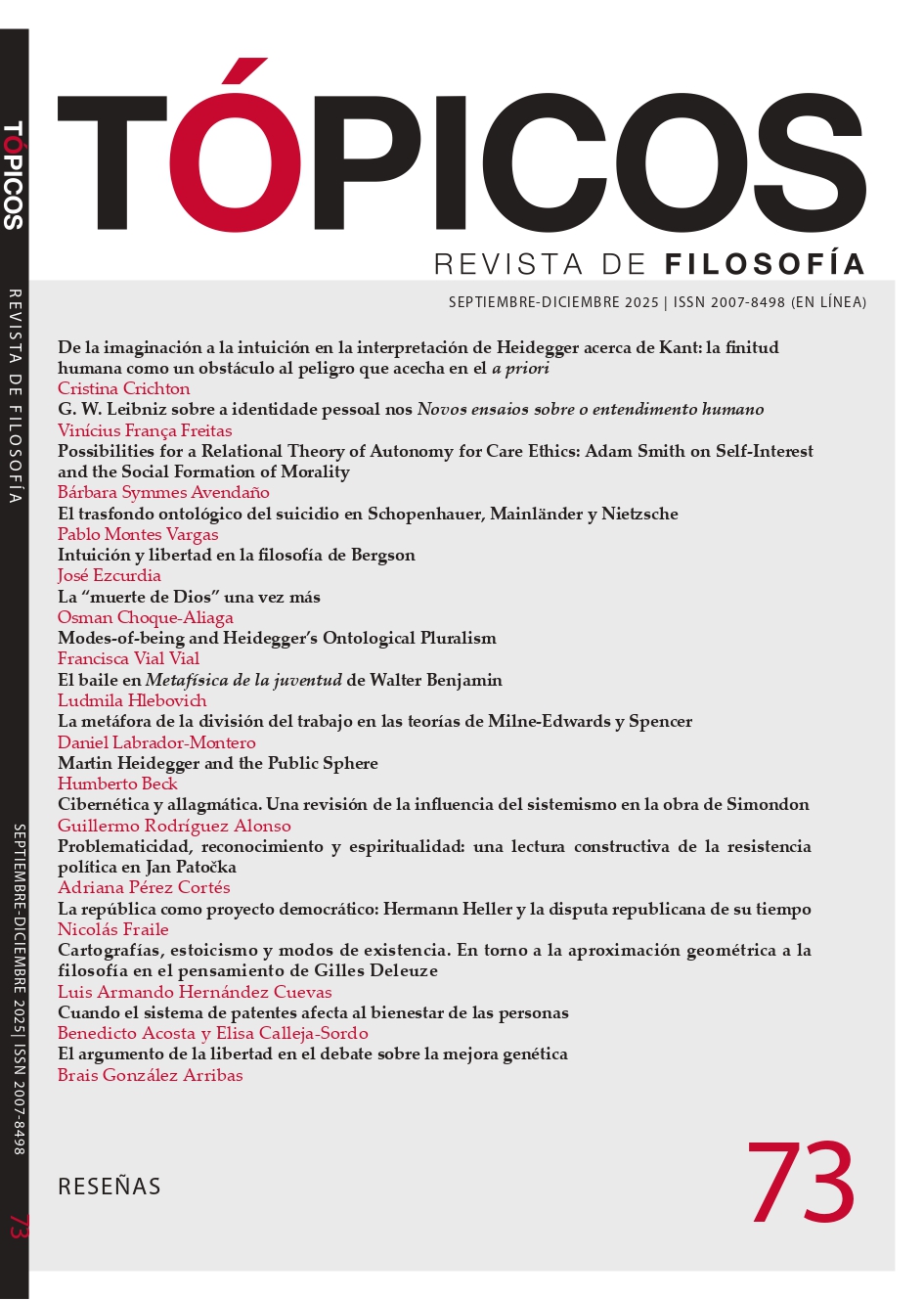Publiée 2025-08-25
Mots-clés
- autonomía procreativa,
- bioconservadurismo,
- control democrático,
- equidad,
- eugenesia
- genoma humano,
- libertad morfológica,
- manipulación genética,
- sistema de salud,
- transhumanismo ...Plus
(c) Copyright Tópicos, Revista de Filosofía 2025

Ce travail est disponible sous licence Creative Commons Attribution - Pas d'Utilisation Commerciale - Pas de Modification 4.0 International.
Comment citer
Résumé
En este artículo se estudia el uso de la categoría de “libertad” por parte de varios de los más influyentes pensadores transhumanistas para justificar la intervención en el genoma humano con fines meliorativos. Así, se analizan los principios de libertad morfológica y de autonomía procreativa, las formas principales en que la idea de “libertad” se materializa en el presente ámbito de estudio. Igualmente, se examinan las correcciones y matizaciones que se plantean a los citados principios desde el propio transhumanismo, ya que es difícil armonizarlos con la igualdad o la equidad social, así como los argumentos que presentan los pensadores bioconservadores, críticos con el transhumanismo y la manipulación genética de la especie humana para su biomejora. La conclusión invita a tomar en serio el presente debate en la esfera pública para que cualquier manipulación genética en humanos, realizada con el fin de mejorar la especie, esté sujeta al control democrático.
Références
- Baylis, F. y Robert, J. S. (2004). The Inevitability of Genetic Enhancement Technologies. Bioethics, 18(1), 1-26. https://doi.org/10.1111/j.1467-8519.2004.00376.x
- Berlin, I. (1958). Dos conceptos de libertad. En I. Berlin, Sobre la libertad (pp. 205-255). Pablo de Azcárate (trad.). Alianza.
- Bostrom, N. (2003). Human Genetic Enhancement: A Transhumanist Perspective. The Journal of Value Inquiry, 37(4), 493-506. https://doi.org/10.1023/B:INQU.0000019037.67783.d5
- Bostrom, N. (2005). A History of Transhumanist Thought. Journal of Evolution and Technology, 14(1), 1-25. https://doi.org/10.5840/jpr_2005_26
- Bostrom, N. (2008). Why I Want to Be a Posthuman when I Grow Up. En B. Gordijn y R. Chadwick (eds.), Medical Enhancement and Posthumanism (pp. 107-136). Springer. https://doi.org/10.1007/978-1-4020-8852-0_8
- Brock, D. W. (2017). ¿Es incorrecto elegir a nuestros hijos? En N. Bostrom y J. Savulescu (eds.), Mejoramiento humano (pp. 263-288). I. Ramia y A. Jiménez (trads.). Teell.
- Buchanan, A., Brock, D. W., Daniels, N. y Wikler, D.(2002). Genética y justicia. C. Piña (Trad.). Cambridge University Press.
- Camps, V. (2002). ¿Qué hay de malo en la eugenesia? Isegoría, 27, 55-71. https://doi.org/10.3989/isegoria.2002.i27.554.
- Chislenko, A. S., Sandberg, A., Kamphuis, A., Staring, B., Fantegrossi, B., Reynolds, D., Pearce, D., Otter, D., Bailey, D., Leitl, E., Alves, G., Wagner, H., Aegis, K., Elis, K., Crocker, L. D., More, M., Sverdlov, M., Vita-More, N., Bostrom, N., Fletcher, R., Spaulding, S., Morrow, T. O. y Quinn, T. (2013). Transhumanist Declaration. En M. More y N. Vita-More (eds.), The Transhumanist Reader (pp. 54-55). Wiley-Blackwell.
- Constant, B. (2020). La libertad de los antiguos frente a la de los modernos, seguida de Libertad de pensamiento. C. Fernández Muñoz (Trad.). Página Indómita.
- Fukuyama, F. (2003). Our Posthuman Future: Consequences of the Biotechnology Revolution. Farrar, Strauss, and Giroux.
- Fuller, S. (2016). Morphological Freedom and the Question of Responsibility and Representation in Transhumanism. Confero Essays on Education Philosophy and Politics, 4(2), 33-45. https://doi.org/10.3384/confero.2001-4562.161206
- Habermas, J. (2002). El futuro de la naturaleza humana. ¿Hacia una eugenesia liberal? R. S. Carbó (trad.). Paidós.
- Harris, J. (2017). Los mejoramientos son una obligación moral. En N. Bostrom y J. Savulescu (eds.), Mejoramiento humano (pp. 137-161). I. Ramia y A. Jiménez (trads.). Teell.
- Hughes, J. (1996). “Embracing Change with All Four Arms:” A Posthumanist Defence of Genetic Engineering. Eubios Journal of Asian and International Bioethics, 6(4), 94-101
- Hughes, J. (2004). Cytizen Cyborg. Westview.
- Kass, L. (2002). Life, Liberty and the Defence of Dignity: The Challenge for Bioethics. Encounter Books.
- Mies, M. y Shiva, V. (2014). Ecofeminismo. Teoría, crítica y persepctivas. M. Bofill (trad.). Icaria.
- More, M. (1993). Technological Self-transformation: Expanding Personal Extropy. Extropy, 10(4)(2), 15-24.
- More, M. (2013). The Philosophy of Transhumanism. En M. More y N. Vita-More (eds.), The Transhumanist Reader (pp. 3-17). Wiley-Blackwell. https://doi.org/10.1002/9781118555927.ch1
- Piedra, J. (2019). Technological Enhancement and Happiness: A Review of Morphological Freedom. Cosmos and History, 15(1), 275-291.
- Raymond, J. (2002). Women as Wombs: Reproductive Technologies & the Battle Over Women’s Freedom. Spinifex Press.
- Rawls, J. (1971). A Theory of Justice. Harvard University Press. https://doi.org/10.4159/9780674042605
- Riechmann, J. (2016). ¿Derrotó el smartphone al movimiento ecologista? Catarata.
- Rothblat, M. (2013). Mind is Deeper than Matter. Transgenderism, Transhumanism, and the Freedom of Form. En M. More y N. Vita-More (eds.), The Transhumanist Reader (pp. 317-326). Wiley-Blackwell. https://doi.org/10.1002/9781118555927.ch31
- Rueda Etxebarria, J. (2020). De la libertad morfológica transhumanista a la corporalidad posthumana: convergencias y divergencias. Isegoría, 63, 311-328. https://doi.org/10.3989/isegoria.2020.063.02.
- Sandberg, A. (2013). Morphological Freedom—Why We Not Just Want It, but Need It. En M. More y N. Vita-More (eds.), The Transhumanist Reader (pp. 56-64). Wiley-Blackwell. https://doi.org/10.1002/9781118555927.ch5
- Sandel, M. (2007). Contra la perfección. La ética en la era de la ingeniería genética. R. Vila Vernis (trad.). Marbot.
- Savulescu, J. (2001). Procreative Beneficence: Why We Should Select the Best Children. Bioethics, 15(5/6), 413-426. https://doi.org/10.1111/1467-8519.00251
- Savulescu, J. (2012). ¿Decisiones peligrosas? Una bioética desafiante. Blanca Rodríguez y Enrique Bonete (Trads.) Tecnos.
- Singer, P. (2017). Decisiones de los padres y mejoramiento humano. En N. Bostrom y J. Savulescu (eds.), Mejoramiento humano (pp. 289-301). I. Ramia y A. Jiménez (trads.). Teell.
- Sloterdijk, P. (2000). Normas para el parque humano. T. Rocha (trad.). Siruela.
- Sorgner, S. L. (2021). El futuro de la educación: mejoramiento genético y metahumanidades. Ethika+, 3, 303-333. https://doi.org/10.5354/2452-6037.2021.61703
- Sorgner, S. L. (2022). We Have Always Been Cyborgs—Digital Data, Gene Technologies, and an Ethics of Transhumanism. Bristol University Press. https://doi.org/10.1332/policypress/9781529219203.001.0001
- Tatchell, J. (2015). Making Human Rights Fit for the 21st Century: The Challenge of Morphological Freedom. Social Epistemology Review and Reply Collective, 4(8), 34-39.
- Vita-More, N. (2013). Life Expansion Media. En M. More y N. Vita-More (eds.), The Transhumanist Reader (pp. 73-82). Wiley-Blackwell, 73-82. https://doi.org/10.1002/9781118555927.ch7





